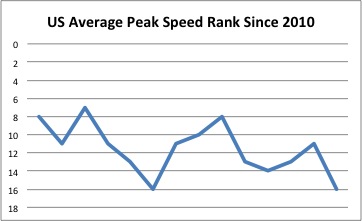Not Falling Behind
 Ed Wyatt’s broadband analysis in the New York Times is a mixture of diverse perspectives and peculiar analysis. While there are different points of view about how well the United States is doing in broadband networking, there aren’t different facts and the article is actually wrong on several of its key claims. The United States is not falling behind the rest of the world in broadband, and I challenge anyone who thinks otherwise to show their data.
Ed Wyatt’s broadband analysis in the New York Times is a mixture of diverse perspectives and peculiar analysis. While there are different points of view about how well the United States is doing in broadband networking, there aren’t different facts and the article is actually wrong on several of its key claims. The United States is not falling behind the rest of the world in broadband, and I challenge anyone who thinks otherwise to show their data.
Second, it’s not the case that broadband users in Chattanooga Tennessee, Lafayette Louisiana, and Bristol Virginia enjoy the fastest speeds in the United States. I researched Chattanooga using the Ookla city database before my appearance on the PBS News Hour in the spring and found that the actual, measured speeds experienced in Chattanooga were below the national average. The disconnect stems from the fact that the high-speed network deployed by the public utility only has a few dozen customers for its gigabit network offering. While extremely high speed networking is available, the vast majority of Chattanooga’s people don’t see any reason to subscribe to it so they use the same options that most people in most of America use: DSL and cable, at speeds that top out at 100 Mbps. I haven’t done the same analysis on Bristol and Lafayette, but I expect the results would be similar. Beware that the Ookla database is so large that Excel has problems with it.
Gigabit broadband is available in most US cities of a million people or more, but usually as a commercial product. Hence, if you’re running a business and have a legitimate need for a 1 Gbps or 10 Gbps network connection, it’s quite likely that you can get it at an appropriate price; most home users can’t get one and wouldn’t know what to do with it if they could. Clue: If you’re not connecting hundreds of users to the Internet, you don’t need a gigabit connection.
The overall premise that the U.S. is falling behind the rest of the world in terms of broadband connection speed is not supported by any historical dataset. Wyatt puts it like this:
The United States, the country that invented the Internet, is falling dangerously behind in offering high-speed, affordable broadband service to businesses and consumers, according to technology experts and an array of recent studies.
So who are these technology experts and what are the studies? The people who claim the US is falling behind tend to be lawyers and other advocates who work in the tech policy space such as Susan Crawford, Marvin Ammori, and the lawyers and public relations officers of organizations like Free Press, Public Knowledge and the Open Technology Institute. It’s a bit charitable to describe these folks as “technology experts” but not unprecedented. More accurately, they’re policy experts and advocates, but that’s a minor quibble.The more important point pertains to the data, and I can’t find an array of studies – or even one – that offers data that would support the “falling behind” claim.
Historical data on international broadband speeds comes from two data sets and only two: Akamai’s quarterly “State of the Internet” report which actually measures TCP connections to Akamai’s CDN at a million points around the world, and from the OECD’s surveys of advertised speeds and prices. Because there are great discrepancies between advertised and actual speeds, I regard the OECD data as essentially useless and rely on Akamai for trend line data. Speedtest/Ookla does not retain speed test data, so you can’t use for trends unless you have a personal cache.
According to Akamai, the United States is not falling behind the rest of the world in broadband speed; it’s simply not happening. In the 4th Quarter of 2009, we had the 22nd fastest Average Connection Speed, and in the most recent data from the 2nd Quarter of 2013, we have the 8th fastest Average Connection Speed. If that is what “falling behind” looks like to you, I suggest you get down off your headstand and stand up on your feet.
UPDATE: Let’s look at two charts taken from the Akamai data. The first shows the U. S. ranking since the 4th Quarter of 2009, ranked according to “Average Connection Speed” that reflects two things: The rate of the underlying broadband pipe and the extent to which it’s shared. Akamai gets this number by measuring TCP streams on a shared broadband connection, so it can’t be any higher than the capacity of the network. It’s an average that is reduced by not only the number of users by also by the nature of the usage. Web browsing will typically reduce this figure by a factor of four because browsers try to do more than one thing at a time (if a page has four pictures, browsers will download them all at the same time, which reduces measured speed.) It’s useful as a relative measure of what the user experiences when browsing the web, but not as an absolute measure of network capacity. It strongly reflects the cost of Internet connections, as costly connections are more likely to be heavily shared.
Figure 1 US Ranking in Average Connection Speed Since 2009. Source: Akamai
Note the 22nd place ranking in 2009 and steady progress toward an 8th place ranking in the most recent quarter. Clearly, this is not what falling behind looks like: the trend line goes up and to the right. This is actually what progress looks like.
On Twitter, Wyatt says he relied on Akamai’s Average Peak Connection speed, a metric they’ve reported since 2010 that more closely resemble the raw capacity of broadband pipes, independent of sharing and parallel usage such as web browsers typically do. It’s much less definitive than the Average Connection Speed as it bounces around quite a bit.
Figure 2 US Ranking in Average Peak Connection Speed Since 2010. Source: Akamai
What we see here is a decline in the 2nd Quarter of 2013 following two preceding quarters of progress. In two previous occasions the U. S. has seen this number decline for two quarters in a row, but so far it has only declined for one. If there’s a trend here, it’s way too early to declare it; one data point does not signal a trend, obviously.
The United States. IS. NOT. FALLING. BEHIND.
The advocates who claim we’re falling behind cannot show any data to support their claim. When asked for data, they will immediately change the subject. Try this experiment in real life, I dare you. Crawford and the OTI will change the subject to prices in lightning speed, and interesting subject in its own right but not really relevant to our international standing in the overall speed and quality of Internet connections.
Wyatt says: “Other studies rank the United States anywhere from 14th to 31st in average connection speed”. Not only does this claim omit Akamai – the most credible source – it also does not establish a trend line. Are we rising, falling, or holding steady? The real answer is that we’re holding steady relative to international competitors on the wired side (over the past year, having moved up from 22nd to 8th in the previous four years.)
We’re also leading the world in wireless, with the most extensive build-out of 4G/LTE in the world.
It’s interesting to compare Wyatt’s story on broadband with another story that appeared in the New York Times on the same day, Nick Bilton’s predictions about the hot technology trends in 2014 on the Bits blog. Bilton sees a promising near-term future for wearable computers such as smart watches, personal robots, location services, body sensors, drones, 3D printers, and TV sets with flexible displays. What all of this gear has in common is a reliance on wireless networks. With the possible exception of smart TV sets – a trend that’s been stalled globally for ten years – all the hot areas for consumer innovation target wireless networks as their primary delivery vehicles. Yet there’s no mention of wireless in Wyatt’s article.
What’s next for broadband networks in the United States?
It’s almost fair to say the United States has declared victory in wired networks and moved on to wireless, where the real action is. We don’t have the fastest wired, consumer-grade networks in the world, but you don’t get a prize for being number one on that list, you only get prizes for being fast enough to enable innovation. We’ve had “fast enough” networks since the 1990s, so that’s no big deal.
We’re probably investing more in mobile and other wireless networks now than we are in residential wired connections, and that’s as it should be. If wireless is the main focus of innovation in consumer products, as Nick Bilton and others maintain, it makes more sense to emphasize mobile networks than to supply couch potatoes with more capacity than they can use. In terms of actual usage, only South Koreans send and receive more data over their broadband networks than Americans do; in most countries with ultra high speed networks, most of the capacity goes to waste.
We’ve made the right decision as a nation in emphasizing policy that encourages investment to flow into the broadband marketplace to support the kinds of innovations that are attractive to consumers. It’s as clear as day that Americans value high speed, high quality wireless networking more than we value couch potato broadband networks we can only use in the living room; we pay more to use them, after all.
There are always going to be policy advocates who insist on fighting the last war, they’re part of the landscape. Given the options of having our broadband choices determined by government bureaucrats or by the market, I’m going with the market warts and all. Being number one in LTE makes a real difference, but being number one in unusable broadband capacity doesn’t. We have a policy system that allows markets to respond to actual consumer needs and desires, not simply to those of Internet policy advocates promoting 20th century wish lists. Let’s keep it that way.






The U.S. is not number one, therefore it’s behind. End of story.
The US is number one in investment, number one in mobile, number one in web-based services (ever hear of Facebook, Twitter, and Google?) We aren’t number on in high-density housing, but I can live with that.